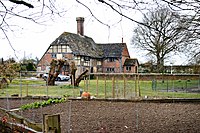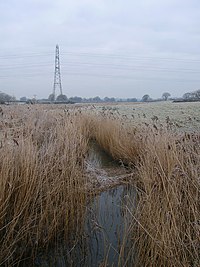Twineham
| Twineham | |
| Sussex | |
|---|---|
 Twineham church | |
| Location | |
| Grid reference: | TQ256198 |
| Location: | 50°57’51"N, 0°12’46"W |
| Data | |
| Population: | 306 (2011) |
| Post town: | Haywards Heath |
| Postcode: | RH17 |
| Dialling code: | 01444 |
| Local Government | |
| Council: | Mid Sussex |
| Parliamentary constituency: |
Mid Sussex |
Twineham is a village in Sussex, found in the midst of the county, five miles to the west of Burgess Hill. The 2011 Census recorded a population of 306.
The village centre has no pub, post office or shop. There is only the church and the school.
Also in the parish is a hamlet, Hickstead, at the eastern end of the parish, on the A23 road, two and a half miles west of Burgess Hill.
The name 'Twineham' is from Old English, perhaps meaning 'Bewteen streams' (Tweoneam), which is a name found in several places across the land. The name is recorded as Tuineam in the late 11th century, Twyne in the 13th century and Twynym in the 15th century[1][2][3]
Contents
The Parish Church
The Parish Church, St Peter's is early Tudor-built with mellow red brick and a Horsham stone roof.
The church is a Grade I listed building.[4] and is made of local brick (the first of that material in middle parts of Sussex) around 1516.[5]
The current church is likely to have replaced a wooden church.
Inside, some of the aisle slabs are of fossil winklestone, from a Sussex marble band that outcrops roughly along, but just south of, Gratten Lane.
There are covered pews, a gallery under the tower. The pulpit and squire's pew have the finest carving: the former Jacobean, the latter Elizabethan. Until recently there was is a Householder's Pew with the old farm names gilded upon it.[4]
The churchyard contains a Quaker burial ground (used between 1694 and 1732) marked by four stone corner posts.
History
In Anglo-Saxon times this area was a royal manor.[6]
This flat waterland geography of the Adur's fingered streams is a land of long, reedy brooks and meadows, wetlands hemmed in by higher ground, or land hemmed in by marsh[7]
The parish embraces the lands between the western and eastern arms of the Adur, and it embraces the confluence of the eastern Adur and the Herrings (or Heron) Stream.
There is another forgotten geography too, that stripes this landscape in long south-north parallels: the geography of the drove roads. Probably early mediæval, maybe some earlier still, these were the wide ways whereby the cultivators of the rich lands of the coastal plain, the Downs, and the under-down spring line, brought their swine for the autumn pannage (nut harvest) in the Wealden woods, and their cattle for the lush bite of the meadowlands. Some of these droves are plain to see like the Wineham Lane. Others have faded greatly into the landscape, though hedgelines and old boundaries mark them out, like that going north from High Cross through Twineham Place, and on to Spronketts Wood north of the A272.[8]
In 1911, the village started to get its piped water supply from the Burgess Hill Water Company. In 1928, the roads were surfaced, and electricity came to the village in 1936. The village of Twineham has never had its own pub, although there are two pubs in the parish of Twineham.
About the village
Slipe is a Grade II* listed building and a former farmhouse, originally a 15th-century timber-framed open hall with a solar wing, modified in the 16th century and restored in the 1920s and late 1940s.[9]
Hickstead Place is a Grade II* listed building and a timber-framed house of different periods, altered from the 18th century onwards; the oldest portions are 15th century.[10]
Part of the All England Jumping Course at Hickstead is located within the parish; however, the International Arena itself, and public access to the course from the A23, are outside the parish, to the south.
Rivers
The eastern River Adur meets Herrings Stream at Twineham (TQ239193). The river then continues to the west of Henfield, where it meets the western Adur to reach the sea at Shoreham-by-Sea. The streams are rich in dragonflied and damselflies; from Hooker's Bridge, along the little Adur west to its confluence with the Herrings Stream and back east to Herrings Bridge there are emperors, chasers, banded demioselles, and much more.[8]
Sport
- Cricket: Twineham & Wineham Cricket Club, founded in 1893, who play at the village's recreation ground
Outside links
| ("Wikimedia Commons" has material about Twineham) |
- Twineham Parish Council
- Twineham Church of England Primary School
- Twineham and Wineham Cricket Club
- Twineham War Memorials
References
- ↑ A History of the County of Sussex - Volume 7 pp 186-191: Parishes: Twineham (Victoria County History)
- ↑ Mawer, A.; Stenton, F.M.; with Gover, J. E. B.: 'Place-Names of Sussex , Part' (English Place-Names Society, 1929/30)
- ↑ Mills, Anthony David: 'A Dictionary of British Place-Names' (Oxford University Press, 2003) ISBN 978-0-19-852758-9
- ↑ 4.0 4.1 National Heritage List 1284819: Twineham
- ↑ Puttnam, C. P. (2007). An introductory History and Guide to St Giles' Church, Shermanbury TD DL
- ↑ Woolf, Alex (2001). "View from the West: An Irish perspective". in Higham, N. J.; Hill, D. H.. Edward the Elder 899-924. Routledge. p. 98. ISBN 0-415-21497-1.
- ↑ Gelling, M. & Cole, A. (2000). The Landscape of Place Names. Shaun Tyas, Stamford .
- ↑ 8.0 8.1 Bangs, David (2018). The Land of the Brighton Line: A Field Guide to the Middle Sussex and Southeast Surrey Weald. Farlington, Portsmouth: Bishops Printers. ISBN 978-0-9548638-2-1.
- ↑ National Heritage List 1025584: Slipe (Grade II* listing)
- ↑ National Heritage List 1181866: Hickstead Place (Grade II* listing)





